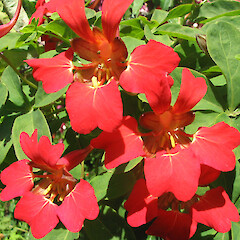Tropaeolum speciosum
Common name
Chilean flame creeper
Family
Tropaeolaceae
Flora category
Vascular – Exotic
Structural class
Lianes & Related Trailing Plants - Dicotyledons
NVS code
The National Vegetation Survey (NVS) Databank is a physical archive and electronic databank containing records of over 94,000 vegetation survey plots - including data from over 19,000 permanent plots. NVS maintains a standard set of species code abbreviations that correspond to standard scientific plant names from the Ngä Tipu o Aotearoa - New Zealand Plants database.
TROSPE
Conservation status
Not applicable
Habitat
Terrestrial. Mainly remnant stands of forest, also scrub, sometimes found in more remote forest clearings.
Detailed description
Climbing perennial, often to high canopy, usually hairless. Rootstock thick. Stems slender, usually with coiling tendrils to 7 cm long, watery sap. Leaves 5-fingered, each leaflet 10-35 x 5-16 mm. Flowers solitary, tubular, 15 mm diam, 5 irregular petals, bottom 3 petals with very slender claw 7-8 mm long, scarlet (occ rose), Nov-Apr. Seed capsule thinly fleshy, of 3 round parts, 1 or 2 often remaining small, 1 cm wide, deep blue.
Similar taxa
Tropaeolum speciosum is very similar vegetatively to Tropaeolum pentaphyllum. T. pentaphyllum only 2 upper petals developed, while T. speciosum has 5 more or less equal petals.
Flowering
November, December, January, February, March, April
Flower colours
Red/Pink
Fruiting
December - March
Life cycle
Perennial; produces seed. Fruit dispersed by birds.
Year naturalised
1958
Origin
Chile
Reason for introduction
Ornamental
Tolerances
Tolerant of warm-cold temperatures, salt, wind, many soil types, damp to dry.
National Pest Plant Accord species
This plant is listed in the 2020 National Pest Plant Accord. The National Pest Plant Accord (NPPA) is an agreement to prevent the sale and/or distribution of specified pest plants where either formal or casual horticultural trade is the most significant way of spreading the plant in New Zealand. For up to date information and an electronic copy of the 2020 Pest Plant Accord manual (including plant information and images) visit the MPI website.











